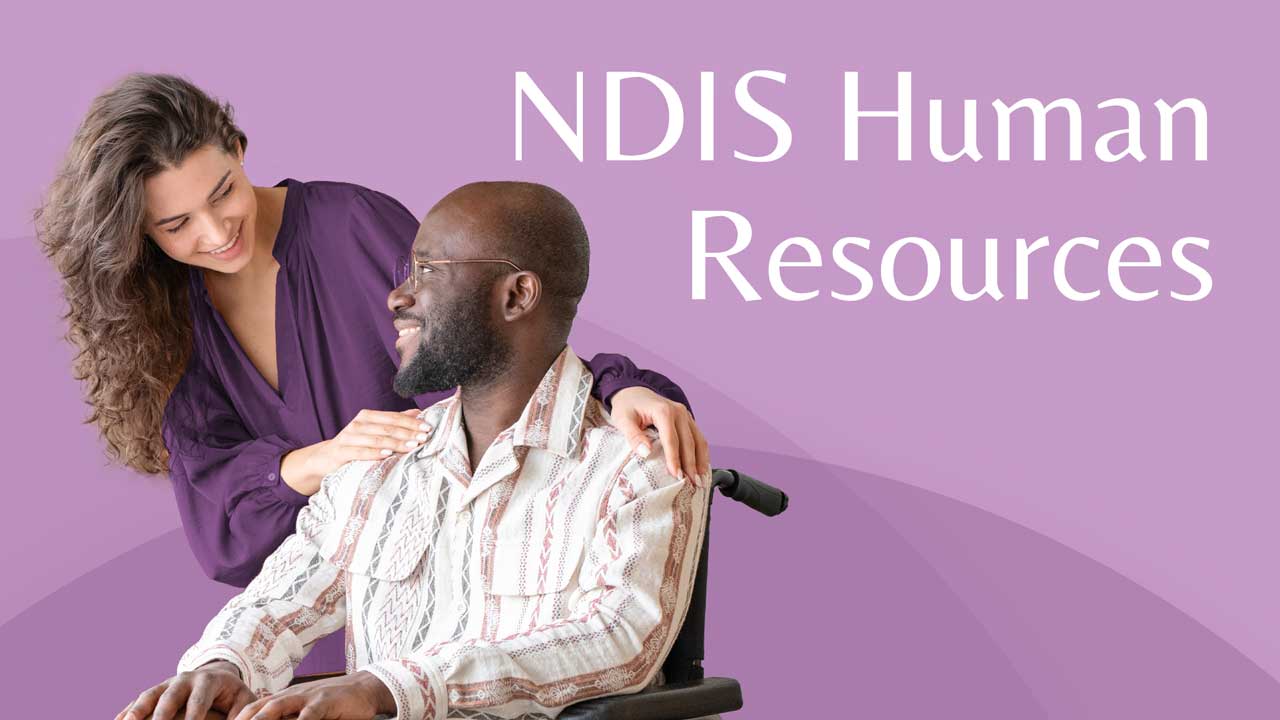Providers of National Disability Insurance Scheme (NDIS) services are expected to follow specific requirements relating to human resource management.
Furthermore, all NDIS workers must understand and adhere to the NDIS Code of Conduct.
These requirements aim to ensure that NDIS participants receive support from workers who are appropriately qualified and experienced and, therefore, able to deliver person-centred support (NDIS 2021).
What is Human Resource Management?
Human resources refers to all of the people who make up an organisation’s workforce (van Vulpen et al. 2024).
Under the NDIS, workers are considered to be any people who are employed or engaged to deliver NDIS supports and services, whether they be paid or unpaid. They include:
- Employees
- Self-employed people
- Contractors
- Consultants
- Volunteers.
(NDIS 2024a)
Human resource management is the way in which this workforce is managed. This might relate to:
- Employment
- Workforce-related policies
- Workforce compensation
- Workforce retention
- Workforce training and development
- Workforce-related legislation (e.g. discrimination laws, compensation laws)
- Workforce protection and safety.
(UMN 2016)
Human Resource Management in the NDIS Practice Standards

Human resource management is a requirement of the NDIS Practice Standards under Core Module 2: Provider Governance and Operational Management.
This Practice Standard aims to ensure that:
- Workers are competent, appropriately qualified and experienced, and have relevant expertise
- Workers are able to deliver person-centred support
(NDIS 2021)
NDIS providers must meet the following quality indicators:
- Each position within the organisation has identified skill and knowledge requirements. The responsibilities, scope and limitations of positions are identified and documented.
- Providers maintain records of workers’ pre-employment checks, qualifications and experience.
- All workers complete an orientation and induction process, which includes completion of the mandatory NDIS worker orientation program.
- In order to ensure that workers are able to meet the needs of each NDIS participant, providers have a system in place for identifying, planning, facilitating, recording and evaluating the effectiveness of workers' training and education. This system identifies mandatory training and includes training related to workers’ obligations under the NDIS Practice Standards and other NDIS rules.
- Workers are able to access timely supervision, support and resources, depending on the scope and complexity of the supports delivered.
- Worker performance is managed, developed and documented. Feedback and development opportunities are provided to workers.
(NDIS 2021)
NDIS Worker Screening Check
The NDIS Worker Screening Check assesses whether NDIS workers or those seeking to become NDIS workers pose a risk to people living with disabilities. Certain job roles (known as 'risk assessed roles') can only be performed by workers who have cleared the screening check (NDIS 2024b).
Risk assessed roles include:
- Key personnel roles as defined by the National Disability Insurance Scheme Act 2013, including CEOs and Board Members
- Roles that involve the direct delivery of specified supports or services to NDIS participants
- Roles that require ‘more than incidental contact’ with NDIS participants, for example:
- Physically touching NDIS participants
- Building rapport with NDIS participants as part of performing routine duties
- Having contact with several NDIS participants through the direct delivery of a specialist disability support or service, or in a specialist disability accommodation setting.
(NDIS 2024b)
Mandatory NDIS Worker Orientation Program
Under the NDIS Practice Standards, all NDIS workers must undertake an orientation module called ‘Quality, Safety and You’ as part of their induction program (NDIS 2022).
The module, which takes about 90 minutes, uses scenario-based learning to explain worker obligations, roles and responsibilities under the NDIS Code of Conduct (NDIS 2022).
Monitoring Worker Performance
Generally, the aims of performance monitoring should be to:
- Establish and clarify workers’ expectations
- Assess workers’ performance
- Plan and review workers’ performance
- Develop workers’ capabilities
- Recognise workers’ achievements
- Resolve unsatisfactory performance.
(ACSQHC 2019)
Test Your Knowledge
Question 1 of 3
True or false: A volunteer is considered to be part of the NDIS workforce.
Topics
References
- Australian Commission on Safety and Quality in Healthcare 2019, Action 1.22: Performance Management, Australian Government, viewed 18 July 2024, https://www.safetyandquality.gov.au/standards/nsqhs-standards/clinical-governance-standard/clinical-performance-and-effectiveness/action-122
- NDIS Quality and Safeguards Commission 2024a, For Workers, Australian Government, viewed 18 July 2024, https://www.ndiscommission.gov.au/workers
- NDIS Quality and Safeguards Commission 2020, NDIS Practice Standards: NDIS Practice Standards and Quality Indicators, Australian Government, viewed 18 July 2024, https://www.ndiscommission.gov.au/sites/default/files/2024-05/ndis-practice-standards-and-quality-indicatorsfinal1_1.pdf
- NDIS Quality and Safeguards Commission 2022, Worker Orientation Module ‘Quality, Safety and You’, Australian Government, viewed 18 July 2024, https://www.ndiscommission.gov.au/workers/worker-training-modules-and-resources/worker-orientation-module
- NDIS Quality and Safeguards Commission 2024b, Worker Screening Requirements (Registered NDIS Providers), Australian Government, viewed 18 July 2024, https://www.ndiscommission.gov.au/providers/worker-screening
- University of Minnesota 2016, ‘1.1 What Is Human Resources?’, in Human Resource Management, University of Minnesota, viewed 18 July 2024, https://open.lib.umn.edu/humanresourcemanagement/chapter/1-1-what-is-human-resources/
- Van Vulpen, E, Verlinden, N & Nemcova, M 2024, ‘7 Human Resource Management Basics Every HR Professional Should Know’, AIHR Digital, viewed 18 July 2024, https://www.digitalhrtech.com/human-resource-basics/
 New
New 
